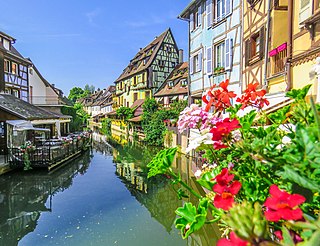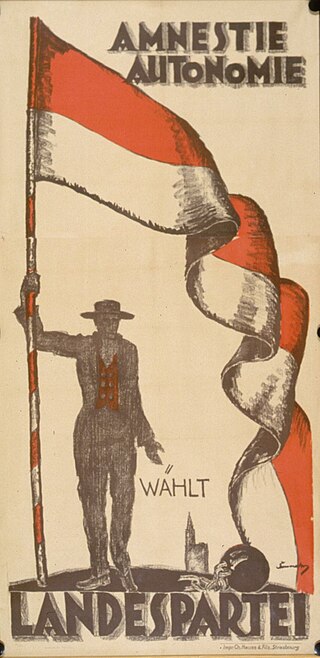Related Research Articles

Alsace is a cultural region and a territorial collectivity in eastern France, on the west bank of the upper Rhine next to Germany and Switzerland. In January 2021, it had a population of 1,919,745. Alsatian culture is characterized by a blend of German and French influences.

Alsace–Lorraine, officially the Imperial Territory of Alsace–Lorraine, was a territory of the German Empire, located in modern-day France. It was established in 1871 by the German Empire after it had occupied the region during the Franco-Prussian War. The region was officially ceded to the German Empire in the Treaty of Frankfurt. French resentment about the loss of the territory was one of the contributing factors to World War I. Alsace–Lorraine was formally ceded back to France in 1920 as part of the Treaty of Versailles following Germany's defeat in the war, but already annexed in practice at the war's end in 1918.

Colmar is a city and commune in the Haut-Rhin department and Alsace region of north-eastern France. The third-largest commune in Alsace, it is the seat of the prefecture of the Haut-Rhin department and of the subprefecture of the Colmar-Ribeauvillé arrondissement.
The Right Opposition or Right Tendency in the All-Union Communist Party (Bolsheviks) was a label formulated by Joseph Stalin in autumn of 1928 for the opposition against certain measures included within the first five-year plan, an opposition which was led by Nikolai Bukharin, Alexei Rykov, Mikhail Tomsky, and their supporters within the Soviet Union that did not follow the so-called "general line of the party". It is also the name given to "right-wing" critics within the Communist movement internationally, particularly those who coalesced in the International Communist Opposition, regardless of whether they identified with Bukharin and Rykov.

The November 1918 insurgency in Alsace–Lorraine is a series of events which occurred when the region of Alsace–Lorraine passed from German to French sovereignty at the end of World War I. During this month, international events were linked to domestic troubles, particularly the German Revolution.
The Bezen Perrot, officially the Breton SS Armed Formation was a small collaborationist unit established by Breton nationalists in German-occupied France during World War II. It was made up of personnel from Lu Brezhon, a Breton nationalist militia, under the leadership of Célestin Lainé.
The Breton Autonomist Party was a political party which existed in Brittany from 1927 to 1931.

Jacques Laurent Peirotes was a French and German politician, mayor of Strasbourg from 1919 to 1929.

Doctor Eugène Adolf Ricklin was an Alsatian politician. He was known for his fiery opposition both to German and French assimilationist policies in Alsace.
The Republicans of the Centre and the Independents of Popular Action were the names given to a parliamentary group in the French Chamber of Deputies of the French Third Republic, composed mainly of Catholic regionalists from Alsace and Lorraine.
The Alsatian Workers and Peasants Party, initially the Opposition Communist Party of Alsace-Lorraine, was a political party in Alsace-Lorraine. The party was led by Jean-Pierre Mourer and Charles Hueber. The party was founded in late October 1929 and was a member of the International Communist Opposition until it was expelled from that organisation in 1934 and gradually moved towards pro-Nazi positions.
Die Neue Welt was a newspaper issued from Alsace, France. It was founded in the end of January 1921 by Charles Hueber, a local leader of the French Communist Party in Alsace. The newspaper was merged into the l'Humanité d'Alsace-Lorraine, the regional edition of the party newspaper l'Humanité, in 1923.

Charles Louis Hueber was an Alsatian politician. He was the mayor of Strasbourg between 1929 and 1935, and a member of the French National Assembly twice.
The Volksfront was a political coalition in Alsace, France, that was formed in 1928 by the Popular Republican Union (UPR), a group of communists led by Charles Hueber, Progressives led by Camille Dahlet and the Autonomist Landespartei. The Volksfront had the goals of greater autonomy for Alsace, safeguards for the German language, the promotion of the Alsatian economy and administrative autonomy for the region. The Volksfront largely represented a continuation of the defunct Heimatbund. The Volksfront showed some similarities of the 1911 National Union, which also had been a loose coalition. Co-operation between Alsatian communists and clerical autonomists had begun with the events of Bloody Sunday (1926).
Elections to the municipal council of Strasbourg were held in France in May 1929 for a six-year term. An autonomist coalition, the Volksfront, defeated an anticlerical and assimilationist coalition of the incumbent socialist mayor, Jacques Peirotes. The Volksfront won 22 seats in the municipal council, with the French Communist Party winning 11 seats, the Autonomist Landespartei five seats, the Popular Republican Union four and the Alsatian Progress Party two seats. The socialist SFIO won four seats and the Democrats seven seats.

The Independent Regional Party for Alsace–Lorraine was a political party in Alsace, France. The party was founded by a group of key supporters of the publication Die Zukunft. The Landespartei represented the radical fringe of the broader Alsatian autonomist movement.
The Protestant Church of the Augsburg Confession of Alsace and Lorraine is a Lutheran church of public-law corporation status in France. The ambit of the EPCAAL comprises congregations in Alsace and the Lorrain Moselle department.

The Alsace independence movement is a cultural, ideological and political regionalist movement for greater autonomy or outright independence of Alsace.
Bloody Sunday may refer to:

Joseph Rossé was an Alsatian politician and autonomist, notable for his engagement in the Union Populaire Républicaine and his controversial role during and after the Second World War.
References
- 1 2 3 4 Goodfellow, Samuel. From Communism to Nazism: The Transformation of Alsatian Communists , in Journal of Contemporary History, Vol. 27, No. 2 (Apr., 1992), pp. 231-258
- 1 2 Fischer, Christopher J. Alsace to the Alsatians?: Visions and Divisions of Alsatian Regionalism, 1870-1939 . New York: Berghahn Books, 2010. p. 187
- 1 2 Callahan, Kevin J., and Sarah Ann Curtis. Views from the Margins: Creating Identities in Modern France . Lincoln: University of Nebraska Press, 2008. p. 146